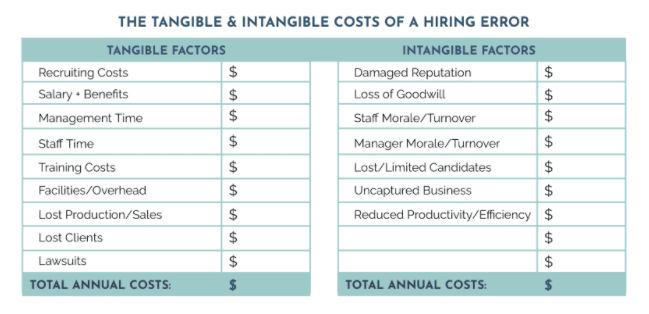Hiring solutions begin with thinking through your company’s culture, needs, and goals.
Article Summary:
The hiring process is the first and crucial step of shaping your company culture. Before hiring, leadership must determine the company’s needs. This involves the leadership team to carefully and strategically define the type of candidate they would want in each role of the company. Putting intentional thought into who you want to hire maximizes your company culture and minimizes turnover.
Article Contents:
How to Determine Your Company’s Needs
Who would you replace if a better candidate came along?
Factors to Consider when Determining Company Needs
Hiring to Maximize Company Culture and Minimize Turnover
Typical Hiring Practices
Think about your last new hire. How did you bring this new employee onto your team?
Most often a new hire comes from a reactive state where there is overwhelm in the company or a current employee has left and there is an immediate need to hire a person to fill that role.
In this scenario, you generally try to throw together a job description, put an announcement on job boards, and hope that enough quality candidates apply.
When I’m working with companies, I often see the hiring decision is based primarily on three things:
- Having a connection with a potential hire
- Liking answers to interview questions
- An impressive resume
But with standard practices like this, you’ll yield standard results. A safe estimate is that only about 20% of new hires succeed in a company. That means roughly 80% of new hires will be gone within two years.
The Cost of a Bad Hire
It’s easier to find a good employee than to make one. When companies rely on their intuition when hiring, they often find themselves in a losing battle of trying to make a new hire work out.
Having 80% of new hires leave within a few years is a good way to run up a large and unnecessary bill for your company. Bad hires are a lot more than just an HR headache.
A bad hire is one of the most costly errors companies make.
The chart below shows just some of the costs associated with employee turnover.


The tangible and intangible costs of hiring the wrong person can cost a company 2 – 3 times that employee’s paid salary. And if the bad hire was in a management or leadership position? That can cost your company up to 10 times as much as their salary.
Without a strategic process in place, your company forfeits the likelihood of finding the right candidate for the right role, and therefore increases unnecessary spending.
How to Determine Your Company’s Needs
An effective hiring process is one of the first steps a company can proactively take to shape a positive and productive company culture. The task of hiring is too important to delegate.
The responsibility of building a high-functioning organization should be driven by those who have an acute understanding of the company goals. Which means, the company leadership is best positioned to affect positive change when bringing on new hires.
There is plenty to consider when hiring new employees, but before you even post a job opening, leadership needs to strategize.
Below are some helpful questions for business executives to consider when brainstorming what exactly your company needs when preparing to fill a job role..
What do you want?
Think about your current business and personal goals when you ask yourself “What do I want?” Business examples might include:
- increased revenue
- less personnel drama
- reduced expenses
Personal examples may include:
- time to focus on your critical tasks
- less stress
- better work-life balance
Also consider the big picture of each position. Is this a supporting role? Will it be a lead role or someone who is able to grow into leadership?
Who do you have?
This question must be answered objectively. When considering current personnel, it is important to assess what is and isn’t working with your current employees.
- Who do you have doing certain tasks?
- Are your employees the right fit for their roles?
- What are your team dynamics?
- Is your company reaching its goals on an appropriate timeline?
Who would you replace if a better candidate came along?
This is another question to be honest about what you have. Do you feel stuck with a person who is not working out? In most situations I’ve seen, when leadership recognizes an employee who isn’t performing optimally, that employee is also dissatisfied in some way in her role.
I remember sitting down with an employee to have a difficult conversation about some things that weren’t working well. I started to lay out my observations only to realize this employee had been feeling the same way. This candid conversation led to our company making a strategic new hire to fill in known gaps. We were then able to modify our current employee’s role in a way that capitalized on her skillset and fulfilled additional needs of our team.
Factors to Consider when Determining Company Needs
You should know who you are looking for before they even walk into the room.
Your strategy must be to determine and document your standards of success for each job role. You can later use these objective criteria to make your decisions.
In the same way that great marketing speaks to one well-defined, ideal client, great recruiting creates job descriptions to fit one well-defined, ideal candidate.
What are the job standards and the behavioral requirements of the one perfect candidate?
Job Standards
- Experience and track record
- Education and training
- Accomplishments
- Intelligence
- Skills
Behavioral Requirements
- Behavioral conduct
- Character
- Attitude
- Emotional Intelligence
- References
Leadership needs to determine the company’s needs regarding these components of a job role.
Hiring to Maximize Company Culture and Minimize Turnover
Clearly defining your ideal candidate for each role in your company will help you assemble a team with a positive culture that drives your company toward its goals.
Hiring with an emphasis on cultural fit often requires a bit more work upfront, but it is a sustainable long-term solution for employee turnover and company success.
Once company needs and employee profiles are established, job descriptions will only need to be reviewed and adjusted as needed.
Knowing and defining who your company is looking for before they even walk into the room ensures that your hiring process will be focused and strategic. Taking this approach allows for unity through hiring and maximizes your company’s new hire success rate.
To learn more about a strategic hiring process for your company, reach out to info@theenclaveway.com or inquire here.

